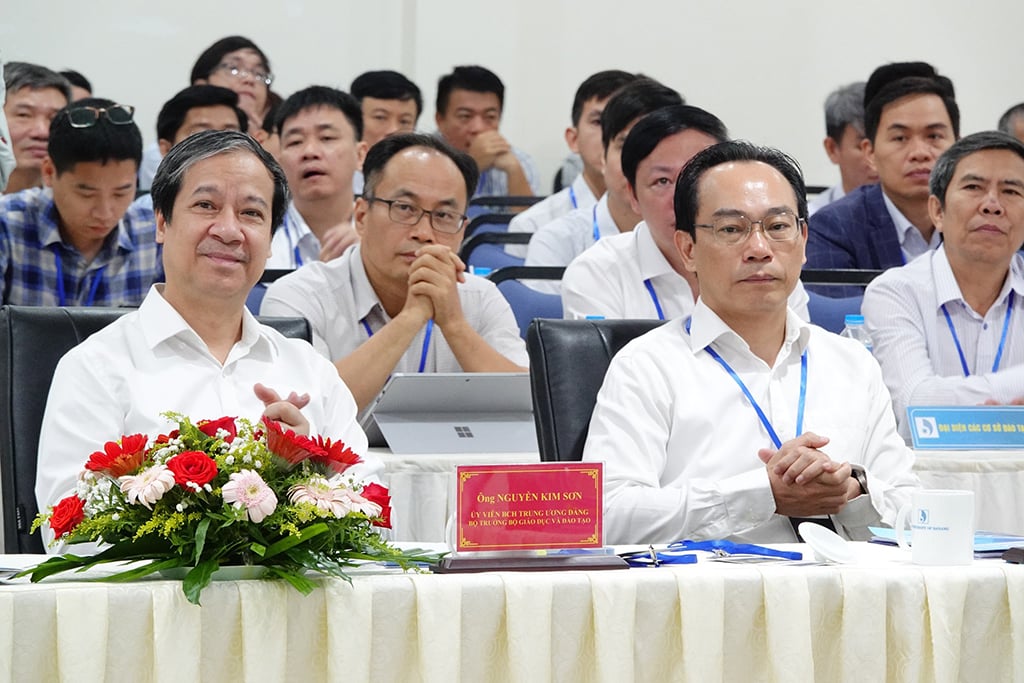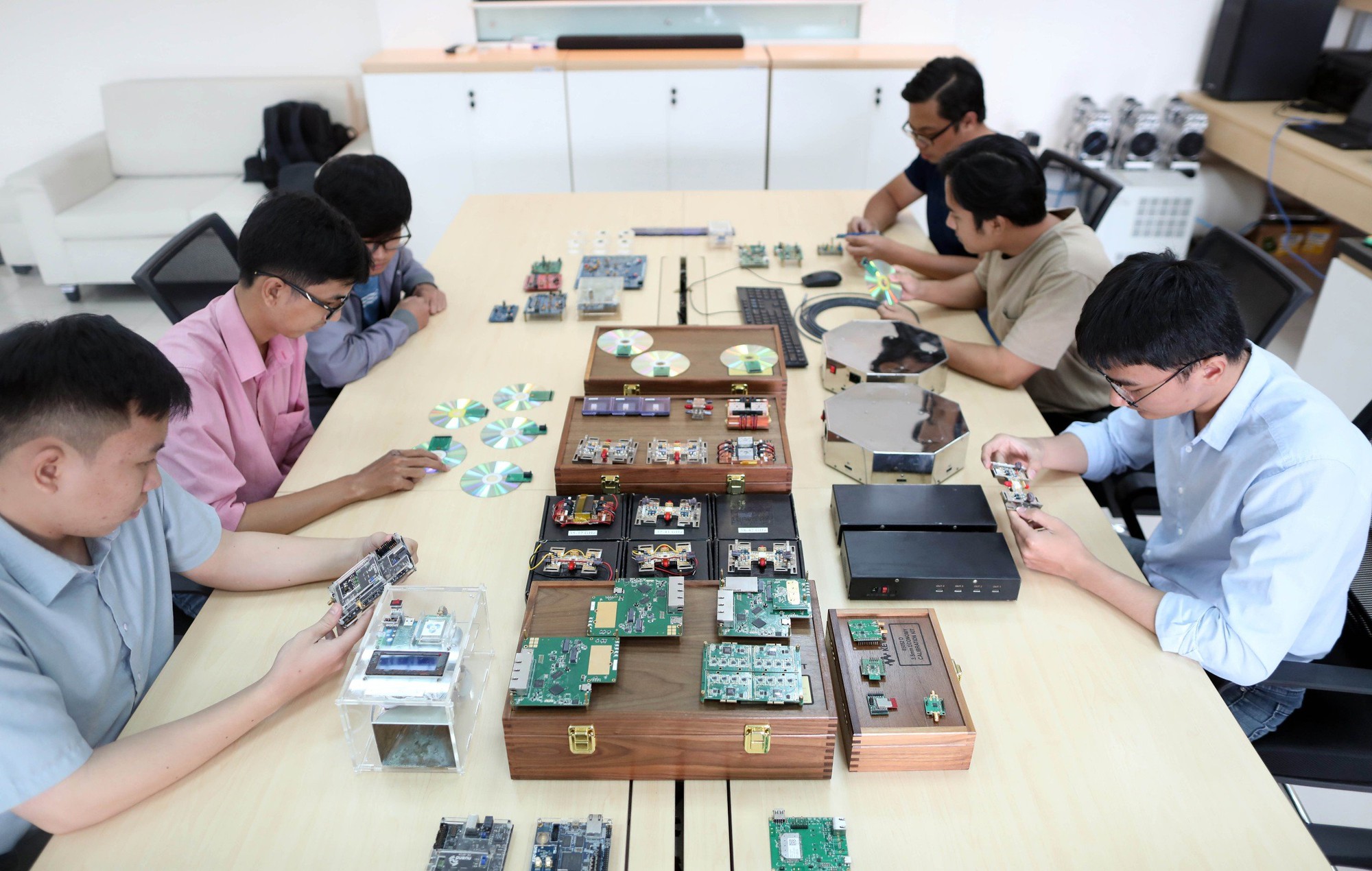SHORTAGE OF HIGH-QUALITY HUMAN RESOURCES
According to Mr. Hoang Minh Son, Deputy Minister of Education and Training, the shortage of high-quality human resources, especially in high-tech fields, is currently a major bottleneck in attracting large technology corporations to relocate their research, development, and production investments to Vietnam. The main reason lies in the objective law of supply and demand between the education and training system and the labor market.
Like many other high-tech industries, the semiconductor and integrated circuit industry requires high investment and a large pool of available human resources. However, students and universities prioritize investing in fields with lower training costs and high demand in the immediate labor market. Therefore, although semiconductor and integrated circuit technology is not an entirely new field of study—some major universities have been offering it for many years—the number of students enrolling and graduating remains very low. This vicious cycle is a major "bottleneck."

Minister Nguyen Kim Son (left) and Deputy Minister Hoang Minh Son (right) at the workshop.
To overcome this "bottleneck," in addition to clear direction, adequate support resources, and effective coordination tools from the State, it is crucial for universities to proactively engage and collaborate with corporations and businesses to train human resources ahead of time, thereby attracting investment and developing the labor market. This will create a feedback loop to attract students, increase the supply of high-quality human resources, and ultimately attract more investment.
OPPORTUNITY FOR VIETNAMESE UNIVERSITIES TO PARTICIPATE IN THE GLOBAL SEMICONDUCTOR ECOSYSTEM
At the seminar, Mr. Bui Thanh Tung from the University of Technology, Vietnam National University, Hanoi , stated that the global semiconductor industry is currently dominated by major countries. However, the average production process for a semiconductor product takes 4-6 months, involving over 500 steps. Therefore, no single country can produce everything independently; a global semiconductor and integrated circuit ecosystem must be formed.
Vietnam has participated in that semiconductor supply chain, even ranking 9th globally in electronics exports, and is considered to have a rapidly developing semiconductor ecosystem with the potential to improve its position in the global semiconductor supply chain. Vietnamese businesses such as Viettel andFPT have begun participating in the global IC supply chain. Intel's packaging and testing plant in Ho Chi Minh City had shipped more than 3 billion chips by the end of 2022. However, Mr. Tung, as well as other delegates, all pointed out the current reality of a severe shortage in both the number and quality of trained personnel with university degrees or higher for this industry. Each year, the semiconductor industry needs 10,000 engineers, but the current workforce only meets less than 20% of that demand.
Currently, training institutions have plans to expand enrollment and training to meet the future demand for highly skilled labor in the semiconductor industry. However, ensuring quality training presents numerous challenges for both schools and the system.

The Microchip and High-Frequency Systems Laboratory at Ho Chi Minh City University of Technology. According to statistics, the highest percentage of personnel working in the semiconductor field are graduates from Ho Chi Minh City University of Technology (26%).
A SERIES OF CHALLENGES
Associate Professor Nguyen Duc Minh, Head of the Electronics Department, School of Electrical and Electronics Engineering (Hanoi University of Science and Technology), pointed out difficulties such as a lack of specialized facilities for semiconductor chips (software, testing equipment, fabrication and experimentation), inconsistent learning materials and laboratory exercises, a low lecturer-to-student ratio, and a low number of students studying the correct specialization. The requirements for facilities (software, equipment) for semiconductor training necessitate significant investment, and the cost of training hardware engineers is high. Furthermore, students prefer software engineering, posing a challenge for universities.
Associate Professor Tran Manh Ha from the Vietnam National University Ho Chi Minh City stated that current universities are facing a series of difficulties such as the lack of a specialized program code for integrated circuit design, insufficient policies to support faculty and experts and attract talented students, a lack of and non-sharing of laboratories for training and in-depth research, and a lack of integrated circuit design research centers connecting businesses with universities, experts, and practical manufacturing, testing, and verification.
According to Dr. Nguyen Trung Hieu from the Posts and Telecommunications Institute of Technology, to address the shortage of high-tech human resources in the semiconductor industry, the State and businesses need to cooperate closely with universities. First, attention must be paid to and development of businesses. Businesses act as both investors and institutions responsible for retraining, internal training, collaborative training, commissioning universities, and providing scholarships for students. Importantly, businesses are the primary source of human resources that universities train. Without a sufficiently large and strong number of businesses, universities will experience an oversupply if they train a large number of students.
According to Associate Professor Pham Bao Son, Vice Director of Hanoi National University, one issue that needs attention is how to have a team of excellent lecturers. In addition to training the existing workforce, universities need to attract talented individuals.

The semiconductor and integrated circuit industry requires high investment and places a demand on available human resources.
MINISTER NGUYEN KIM SON : "WE HAVE A GREAT OPPORTUNITY"
In his concluding remarks at the workshop, Minister of Education and Training Nguyen Kim Son stated that October 19th is a memorable milestone in the journey of the higher education system contributing to the creation and development of Vietnam's semiconductor industry in the future. "I want to emphasize the word 'TIMING'. This is a moment, a crucial opportunity. At this time, if we can seize it, we have a great chance," Minister Nguyen Kim Son said.
According to the Minister, the time is ripe. The mission and responsibility of participating in the development of the semiconductor technology sector, elevating the country's status and position, rests on the shoulders of the entire higher education system. "We must not miss this opportunity; if we do, we will be guilty towards the country. If we succeed, we will raise the national standing and the standing of the entire higher education system," the Minister shared.
Minister Nguyen Kim Son argued that besides the word "TIMELY," we need to mention "HIGH": the demand is high, the field is high-tech, requires high investment, high demands, high expectations, and learners can earn high incomes… In particular, training must be conducted with a spirit of high quality, and a very high level of determination is needed to achieve this.
According to the Minister, it is crucial to have breakthrough solutions. On the part of the Ministry of Education and Training, for schools that are determined enough to demonstrate their capabilities, the Ministry is ready to allow them to enroll students early. The Ministry of Education and Training is ready to issue special circulars and regulations; special regulations to attract experts, establish training partnerships, allow the use of each other's programs, and utilize foreign programs…
Which schools produce a large number of professionals working in the semiconductor field?
The highest percentage of personnel working in the semiconductor field are graduates from the University of Technology - Vietnam National University Ho Chi Minh City (26%); followed by the University of Science - Vietnam National University Ho Chi Minh City (18%); Ho Chi Minh City University of Technology and Education (12%); Hanoi University of Technology (9%); Can Tho University (7%); University of Information Technology - Vietnam National University Ho Chi Minh City (6%); University of Technology - Da Nang University (6%); Posts and Telecommunications Institute of Technology (3%); and the International University - Vietnam National University Ho Chi Minh City (3%).
Mr. Nguyen Phuc Vinh , Technical Director of Synopsys Vietnam Co., Ltd.
Average income of university-educated personnel in the semiconductor field.
Mr. Nguyen Phuc Vinh, Technical Director of Synopsys Vietnam Co., Ltd., announced the following figures on the average after-tax income of university-educated personnel working in the semiconductor industry by seniority (in million VND/year): Year 1: 219.35. Year 2: 241.29. Year 3: 265.14. Year 4: 291.95. Year 5: 321.15. Year 6: 353.27. Year 7: 388.59. Year 8: 420. Year 9: 470.20. Year 10: 517.22. Year 11: 568.94. Year 12: 625.83. Year 13: 688.41. Year 14: 757.26. Year 15: 832.98. Year 16: 916.28. Year 17: 1,007.91. Year 18: 1,108.70. Year 19: 1,219.57. Year 20: 1,341.52.
Source link




![[Photo] Enchanting ancient rose garden on the mountainside in Nghe An](/_next/image?url=https%3A%2F%2Fvphoto.vietnam.vn%2Fthumb%2F1200x675%2Fvietnam%2Fresource%2FIMAGE%2F2025%2F12%2F19%2F1766109900916_vuon-hong-chin-do-thu-hut-du-khach-toi-check-in-o-ha-noi-3-20162778-1671624890024-1671624890104198100259.jpeg&w=3840&q=75)

![[Photo] General Secretary To Lam visits the exhibition space showcasing books, photo exhibitions, and achievements of digital transformation in journalism.](/_next/image?url=https%3A%2F%2Fvphoto.vietnam.vn%2Fthumb%2F1200x675%2Fvietnam%2Fresource%2FIMAGE%2F2025%2F12%2F19%2F1766110879215_1766110240024-jpg.webp&w=3840&q=75)











































































































Comment (0)